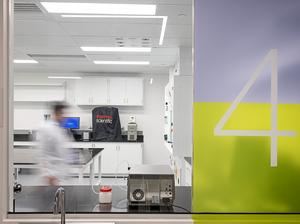They’re at it again. The brainiacs at MIT have stumbled upon yet another invention that will change the world. We’re sure of it. This time, they are attacking the issue that we all face at work. One moment, you’re freezing your fingers off at your desk and must stop because you can no longer type and the next minute, you’re sweating bullets and walk into the kitchen to get your “lunch” just so you can stand at the open refrigerator door. Thanks to a team from MIT, throwing temperature tantrums will now be a thing of the past.
A new invention from Wristify, which took first place at the Making And Designing Materials Engineering Competition (MADMEC) on Tuesday afternoon, is here to make that dream possible. Wristify's invention is a thermoelectric bracelet that has the ability to maintain the wearer’s comfortable body temperature. In other words, this is the invention to stop all those chills and sweats you experience at work if your office has the same oscillating climate as New England.
"We all have had an experience where we've been uncomfortable and not had the ability to adjust our thermal comfort," co-inventor and MIT's Materials Science Department graduate student Michael Gibson told BostInno. He further explained that he and his fellow inventors have all experienced events in their lives that led to the decision to take charge of their own temperature environments.
"Sam (one of my co-inventors), was motivated by seeing his mom wear fleece wrist warmers all winter because she's always cold," Gibson said. "For me, it was that I roomed with someone from a tropical climate my freshman year at MIT. I would be uncomfortably warm in the same room where he was uncomfortably cold."
With their first-place prize, Wristify received $10,000 from the annual competition, which is added to the initial $1,000 each group receives to build their prototypes. Starting in June, monthly checkpoints and independent design challenges are completed to ensure each group stays on track.
The four-person group of MIT engineering students that make up Wristify worked with the same principles that are applied when a towel is used to keep a person warm. The thermoelectric bracelet monitors air and skin temperature and then, based on the readings it gathers, it sends tailored pulses of hot or cold wavefronts to the wrist to help maintain thermal comfort.
What this means is that this new device, powered by a lithium polymer battery, could eventually save energy on temperature control at office buildings around the city because the device will be cooling and heating the individual rather than the entire office.
"The need for a stylish, wearable means of adjusting your thermal comfort — especially independent of everyone else around you — is very real," Gibson said. "Our other motivation relates to sustainability: 16.5 percent of U.S. energy use comes from heating and cooling buildings. We started with the question: Why heat or cool an entire building, when you could heat or cool a person instead?"
Based on their experimenting, the team, which also includes materials science and engineering senior Sam Shames, graduate student David Cohen-Tanugi and postdoc Matt Smith, estimates that if the device stops one building from adjusting its temperature by even one-degree Celsius, it will save about 100 kilowatt-hours per month. To put that into perspective, a typical house generally guzzles about 150 to 1500 kilowatt-hours per month, depending on the weather and how many people live in the house. Therefore, using these bracelets could save the energy that could then be used to heat a small house.
Through their project development, the Wristify team discovered that the body is sensitive to minute and rapid changes in temperature, which affect the whole body. Think back to that time when you were about five and placed your hand on a hot stove. The sensation you felt after that should be proof that this is true. In order to make the entire body feel, overall, several degrees warmer or colder, the team had to cool or heat a body part (the wrist) at a rate of at least 0.1 degree Celsius per second. After 15 prototypes, the team was able to develop a bracelet that could hit a rate change of 0.4 degrees Celsius per second.
Where the watch part of the bracelet would normally be sits the team’s custom copper-alloy-based heat sink, a gadget that lowers a device’s temperature by dissipating heat. Attached to that is an automated control system that manages the intensity and duration of the thermal pulses delivered to the heat sink. There are also integrated thermometers used to measure external body temperature that enable the bracelet to adjust accordingly.
Not only will this arm bling be effective, the team also hopes it will be something wearers find stylish.
"Our goal over the summer was to demonstrate a technical proof-of-concept and start getting market feedback on what people want out of a device for personal thermal comfort," Gibson said. "Now that we've done that, we're looking to optimize our device for both wearability and performance. Of course, a big part of wearability is style, so we're definitely looking to start working with an industrial designer to make this thing look as awesome as it feels."
Shames told MIT News he that he and his team have developed a “wearable, wrist-based technology that leverages human sensitivity, can detect and perfect rates of change and can maintain overall thermal comfort while reducing the need to heat and cool buildings.”
In other words, this is a sustainability dream — the theme of this year's MADMEC.
Wristify plans to further develop this prototype with the prize money they received from the competition — developments that include using advanced algorithms to better automate thermal pulses, among other changes. Sounds simple to us.
MADMEC, not to be confused with Mad Men, held its first competition in 2007, which produced Levant Power, the third-place winner that has performed successful shock absorber tests with both the U.S. military and city buses in New York. MADMEC is run by MIT's Department of Materials Science and Engineering.
"In the short term, we hope to offer everyone in the Boston community (and the world) the opportunity to personalize their thermal comfort with a stylish, wearable device," Gibson said. "In the long term, we hope to have a real impact on energy and carbon emissions by making it easier for people to adopt sustainable behaviors with heating and cooling buildings."
While we are still unsure about the new wrist phones, Wristify’s new piece of metal is one piece of arm bling we think we could get used to.
Featured Image via Hardware.com.








